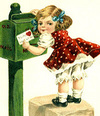Biogardener Homepage
with links to my other websites
Trees & Shrubs
Mother Nature's way
Getting Started Organically
start with the basics
Environmental Issues
legal and practical
Edible Garden
for food, drink & medicine
Traute Klein, biogardener
Webmaster's background & work
Biogardener Guestbook
Please Sign
or Read Entries
 Send me your own organic gardening story. Email me by clicking on the mailbox graphic. Send me your own organic gardening story. Email me by clicking on the mailbox graphic.
Other Pruning Articles
Pruning Fruit Trees, Introduction
The why and when of pruning fruit trees of the rose family: apple, cherry, plum, peach, nectaring, apricot.
Principles of Tree Pruning
Every type of tree or shrub has its own growing timetable which determines the proper pruning time. Pruning at the wrong time is counterproductive.
Amazon Books
More Tree & Pruning Books
|
Fruit Tree Pruning, Instructions
by Traute Klein, biogardener
Here's how to prune fruit trees of the rose family for optimum fruit production. Step by step instructions. The article explaining the why and when of the pruning is linked in the left column, "Fruit Tree Pruning, Introduction." It also explains how to recognize rose family fruit trees. These trees must be pruned in their dormant stage, i.e. after the leaves fall off but before the new buds sprout.
Pruning for Optimum Fruit Production
To grow large healthy fruit, it is necessary to reduce the number of fruit on each branch. Here are my basic rules for the procedure:
- Cut out any dead or damaged branches almost flush with the branch from which they grew.
- Cut out the weakest branches and leave only the ones which are strong enough to support the weight of fruit.
- Don't worry about cutting off too many branches. Everyone makes the mistake of cutting off way too few. If, however, the tree has not been pruned for years, don't try to catch up in one single season. Leave some for next year. Too much pruning at one time can traumatize the tree.
- Now have a look at all the shoots which have grown since last spring. Each one needs to be shortened severely. There are more than you thought, right? I am sure that you will now want to go back to cut off some more branches before you proceed to the next step.
- Take another look at just one single new twig which grew in the previous year. Where each leaf has fallen off, you will see one bud. Each of these buds will produce a piece of fruit next season (except for the trees which grow fruit in clusters, like cherries). How many pieces of fruit do you think a branch can support comfortably? That is the number of buds which you leave, snipping the tip of the twig off with sharp pruning sheers. I like to leave 3 or 4 buds. The more you leave, the smaller the fruit will be.
And next winter, do it all over again. The better I do my job, the larger my fruit. Books tell you to leave 5 or 6, but I prefer a lower number for two reasons. I would rather have 1 large apple than 2 small ones, and I also like to slow down the growth of the tree. High fruit is difficult to reach.
To Dress of not to Dress
There is no need for covering the wound. If the pruning is done during the dormant period, trees won't bleed, because there is no sap flowing at that time, at least not here in the prairies where the soil is frozen solid. If the pruning is done while the tree is bleeding, the dressing won't do any good anyway, because it will bleed right through the dressing. During the dormant period there are no bacteria or pests around which would damage the tree through its wound. At any rate, a healthy tree produces its own protection against infection.
You may, however, paint the bark of fruit trees with diluted white latex paint in autumn. It keeps the intensely bright prairie sun from heating the dark bark. That heat tends to crack the bark. I learned that trick from my friend Ernie Kackenhoff who owns Manitoba's largest tree nursery in St. Norbert, just south of Winnipeg. He grew up in a family of tree nurserymen near Hamburg, Germany.
© Traute Klein, biogardener
-
|
 Send me your own organic gardening story. Email me by clicking on the mailbox graphic.
Send me your own organic gardening story. Email me by clicking on the mailbox graphic.